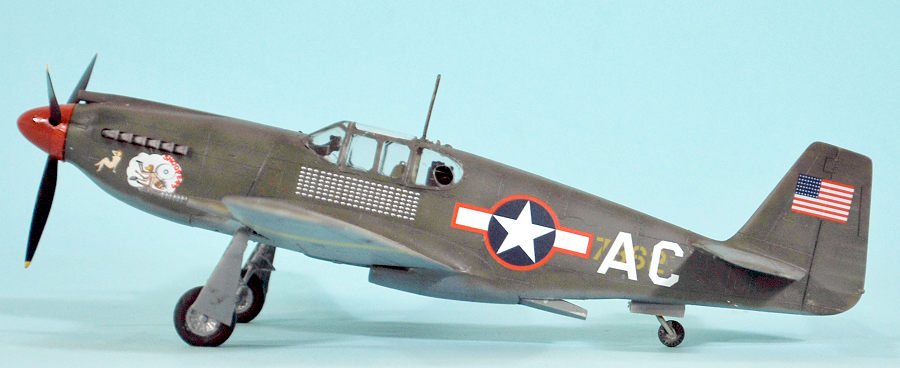
Accurate Miniatures 1/48 F-6A Mustang
| KIT #: | 480017 |
| PRICE: | $20.00 'used' |
| DECALS: | One option |
| REVIEWER: | Tom Cleaver |
| NOTES: |

| HISTORY |
Everyone "knows" that the Mustang was the airplane designed and built in 120 days for the British because North American's Dutch Kindelberger didn't want to build Curtiss P-40s under license, and that the first Mustangs were a disappointment because they were hobbled by the godawful Allison engine, and that the airplane only became "good" when it was powered by the mighty Merlin. Right? That's the stuff in all the Mustang books, isn't it?
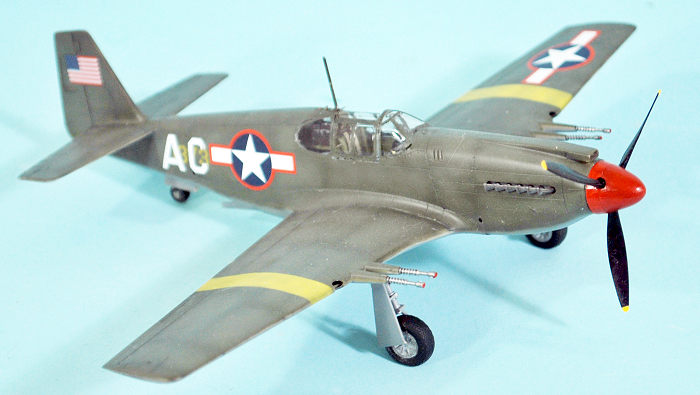 Well,
yes, all that is in the "history books," many of which are written by people
who prove the old saw that if you copy from one it's plagiarism, while if
you copy from many it's research; and if the many have copied from each
other, mistakes can indeed become "facts." (The most recent of these is
titled: “Wings of War” and should be ignored) We are only now, 80 years
after the events, starting to discover that a lot of what was written as
history at the outset was "uninformed" to be generous, and then was copied
by those who followed, to the point that it became "the truth" because it
had been repeated so many times.
Well,
yes, all that is in the "history books," many of which are written by people
who prove the old saw that if you copy from one it's plagiarism, while if
you copy from many it's research; and if the many have copied from each
other, mistakes can indeed become "facts." (The most recent of these is
titled: “Wings of War” and should be ignored) We are only now, 80 years
after the events, starting to discover that a lot of what was written as
history at the outset was "uninformed" to be generous, and then was copied
by those who followed, to the point that it became "the truth" because it
had been repeated so many times.
So far as the Allison-powered Mustang being a "disappointment" is concerned, Southern California aviation legend the late Rev. B.C. Reid - who flew every kind of Mustang there was with the 107th Tac Recon Squadron of the 67th Tac Recon Group during 1943-45 - told me that the Allison Mustang was to the Mustang series what the Bf-109F was to Messerschmitt's fighter: the best combination of engine and airframe for flight harmony. "After the A-model, they kept adding weight more than they added power," he once told me, "and the D-model was an underpowered truck in comparison with the A-model. Its only grace was it could fly high." In terms of performance, when an RAF Mustang IA was test-flown against a captured Fw-190A, there was little to choose between the two up to 23,000 ft. and the Mustang could outrun the Focke-Wulf below 15,000 ft.
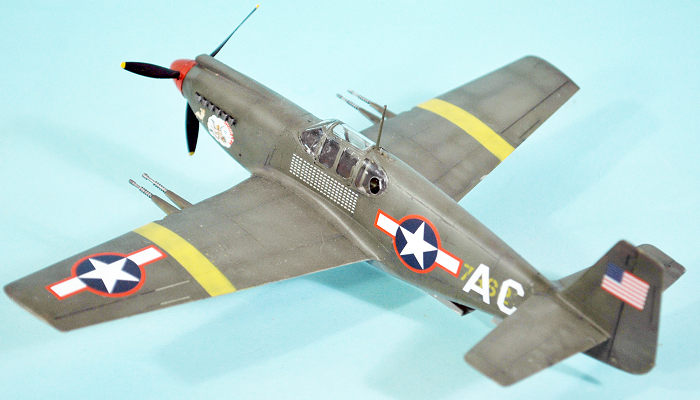 After
the RAF ordered the Mustang I and the USAAF got around to testing the two
examples that had been provided to Wright-Patterson (where they were ignored
for six months), the USAAF ordered a version armed with four 20mm cannons as
the P-51; 55 of which were taken from the Lend-Lease order for the Mustang
IA for the RAF. After being tested in the tactical reconnaissance role the
RAF was using their Mustangs in, the airplanes were modified for the Tac-R
role, where they were initially known as “P-51/Tac-R,” the F-6A designation
only showing up in 1944 and never used in the field.
After
the RAF ordered the Mustang I and the USAAF got around to testing the two
examples that had been provided to Wright-Patterson (where they were ignored
for six months), the USAAF ordered a version armed with four 20mm cannons as
the P-51; 55 of which were taken from the Lend-Lease order for the Mustang
IA for the RAF. After being tested in the tactical reconnaissance role the
RAF was using their Mustangs in, the airplanes were modified for the Tac-R
role, where they were initially known as “P-51/Tac-R,” the F-6A designation
only showing up in 1944 and never used in the field.
The USAAF sent 35 P-51/Tac-R Mustangs to North Africa in 1943, where they equipped the 111th Tactical Reconnaissance Squadron (formerly the 111th Observation Squadron from the Texas National Guard). The squadron began re-equipping in March 1943 and was declared operational in May, just in time to not see use in the North African campaign.
The Mustangs found lots of use in the Sicilian and Italian campaigns. The survivors were only retired from active service beginning in the summer of 1944, and two stayed with the squadron until April 1945.
Pretty good for a “disappointment.”
| THE KIT |
 Accurate
Miniatures first releases way back in 1995 were the three Allison-engine P-51s,
the P-51, P-51A and A-36. The P-51 and P-51A were both re-released in RAF
markings. When the original company went bankrupt and was bought by a new group,
they managed to become known by modelers as “Inaccurate Miniatures,” due to
their hit-and-mostly-miss re-releases of the kits. After they went bankrupt, the
molds have been licensed for production by other companies, most recently
Italeri.
Accurate
Miniatures first releases way back in 1995 were the three Allison-engine P-51s,
the P-51, P-51A and A-36. The P-51 and P-51A were both re-released in RAF
markings. When the original company went bankrupt and was bought by a new group,
they managed to become known by modelers as “Inaccurate Miniatures,” due to
their hit-and-mostly-miss re-releases of the kits. After they went bankrupt, the
molds have been licensed for production by other companies, most recently
Italeri.
This particular kit, an “Inaccurate Miniatures” release as the F-6A Tac-R Mustang, was discovered at the LHS Estate Sale. I had received the new Czechmaster resin cockpit and radiator detail sets, so I decided to use them in this project.
| CONSTRUCTION |
Since the resin parts were used in the fuselage, this was the main area of work. I first cut out the waste gate area from the fuselage parts, then glued each nose part to the relevant fuselage half before proceeding.
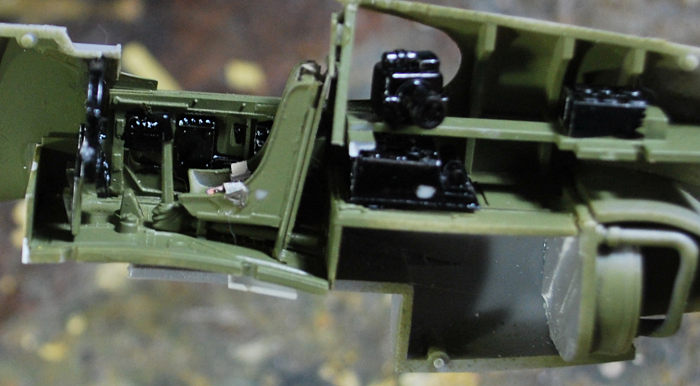 The
Czechmaster Resin cockpit is basically a re-pop of the old Squadron True Details
cockpit that is now made of unobtanium. Unfortunately, they made one change from
that set that is nearly fatal: the cockpit floor part is not thin as it should
be. One can only use that if you were to cut out the center of the gear wells in
the wing. I ended up using the plastic floor, which fit fine and allowed me to
proceed. This cockpit is a good upgrade for detail over what’s in the kit.
The
Czechmaster Resin cockpit is basically a re-pop of the old Squadron True Details
cockpit that is now made of unobtanium. Unfortunately, they made one change from
that set that is nearly fatal: the cockpit floor part is not thin as it should
be. One can only use that if you were to cut out the center of the gear wells in
the wing. I ended up using the plastic floor, which fit fine and allowed me to
proceed. This cockpit is a good upgrade for detail over what’s in the kit.
The resin radiator shows how different that was from the later Merlin Mustang radiators. It fits easily, but I discovered when the model was finished that with the resin waste gate opened to what was the maximum, it’s very difficult to see anything inside. This is one of those sets best used by the “I don’t care if I can’t see it, I know it’s there” modelers.
The rest of the assembly was very straightforward. If you exercise care in this process, you can have the model assembled without need of filler anywhere.
I decided to close up the cockpit since the plastic was clear enough to see the interior.
| COLORS & MARKINGS |
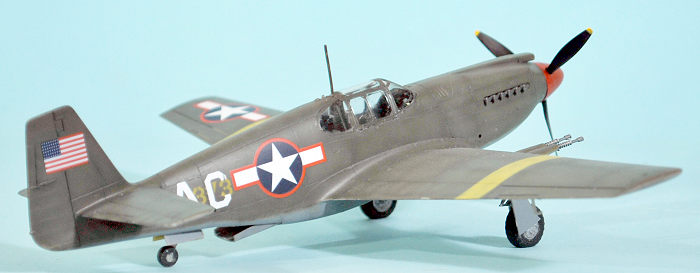 I went
for a “sun-faded” look on this. I first painted the yellow stripes on the wings
and masked them off, since the decals for this aren’t really much good. I then
painted the model with Tamya XF-81 RAF Dark Green, which is a match for early
war “green base” OD-41, which I then lightened with increasing amounts of light
grey when I went back over the model to “fade” the paint. The lower surfaces
were painted with Tamiya XF-53 “Neutral Grey.”
I went
for a “sun-faded” look on this. I first painted the yellow stripes on the wings
and masked them off, since the decals for this aren’t really much good. I then
painted the model with Tamya XF-81 RAF Dark Green, which is a match for early
war “green base” OD-41, which I then lightened with increasing amounts of light
grey when I went back over the model to “fade” the paint. The lower surfaces
were painted with Tamiya XF-53 “Neutral Grey.”
The decals went on without problem. You may note that the serial number that is “overmarked” with the later insignia and the ID letters is the same for both sides. This bothered me enough to use other decals to make the number right, then apply the insignia and ID letters over it. The result wasn’t really worth the effort, since you are highly unlikely to notice that unless you are a fanatic for markings.
I attached the wheels and prop and cannon barrels and declared things done.
| CONCLUSIONS |
There’s a reason why these kits keep getting re-released now going on 28 years since they first appeared: they’re good. No one else has done the Allison Mustang. The kit benefits from upgrades like the resin cockpit, and the Squadron vacuform canopies can still be found for reasonable prices on eBay.
Review kit courtesy of my wallet.
9 February 2023 Copyright ModelingMadness.com.
All rights reserved. No reproduction in part or in whole without express
permission. If you would like your product reviewed fairly and
fairly quickly, please
contact
the editor or see other details in the
Note to
Contributors.